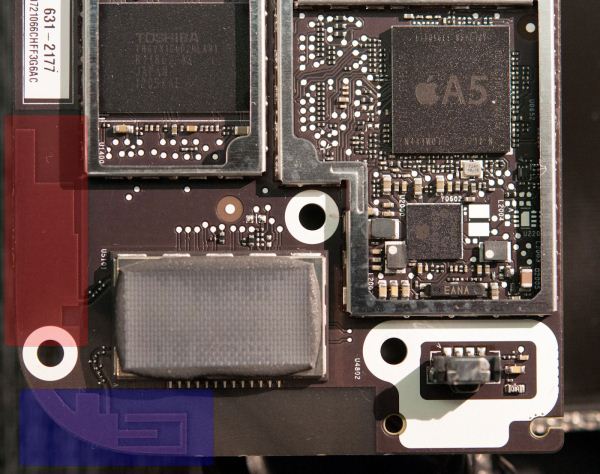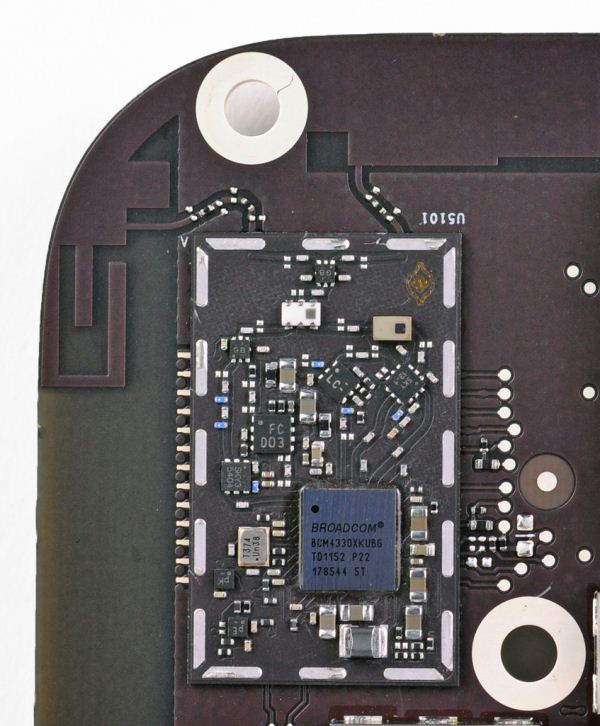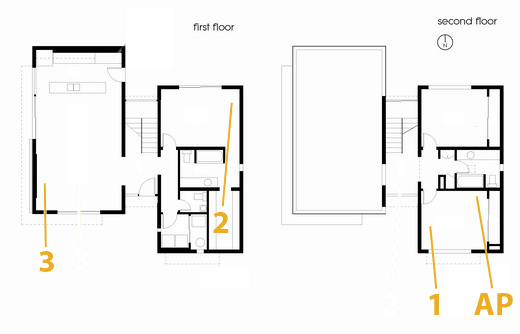Apple TV 3 (2012) Short Review - 1080p and better WiFi
by Brian Klug on March 21, 2012 4:21 PM ESTI touched on the fact that the Apple TV 3 now has two WiFi antennas printed on its PCB. The first appears to be of similar design to the Apple TV 2, and it's obvious from visual inspection that this is the case. The second is adjacent and shares the same ground plane / metal layer.

Antenna 1 (Encircled in blue), Antenna 2 (Encircled in red)
In addition, the Apple TV 3 also moves from Broadcom's BCM4329 802.11a/b/g/n and BT 2.0+EDR combo chip to BCM4330 802.11a/b/g/n and BT 4.0 combo chip which we've seen in the iPad 3, iPhone 4S, and countless other mobile devices. Seeing two RF chains, you might be led to think that the Apple TV 3 has 2x2:2, however this is not the case as the device still will only connect at 65 Mbps - single spatial stream, 20 MHz wide channels with the long guard interval. The maximum PHY rate and presence of 2.4 and 5 GHz band support is unchanged from Apple TV 2.

BCM4330 - Courtesy iFixit
One of the main complaints that I read online of the Apple TV 2 was its performance on 2.4 GHz. If you're living in the Apple ecosystem with an Airport Extreme or have a 5 GHz AP, this previously is something you could've not noticed entirely. In addition, multimedia streaming seems to be the ideal use case for 5 GHz WLAN thanks to both the ability to run 40 MHz channels and deal with less congestion. However, for users with 2.4 GHz networks, gain on that band is important.
It's obvious that the inclusion of a second WLAN chain and antenna is an attempt to improve RF performance further, even though the jump from 720p to 1080p for iTunes content doesn't increase bitrate very much at all (more later). To show just how much things have changed, I turned to the FCC documents for both Apple TV models which spell out antenna gain. Interestingly enough, the FCC also had internal photos up and posted the day the Apple TV 3 went on sale, which could've saved everyone some teardown time.
| Apple TV 2 and 3 - Antenna Gain | ||||||||
| Antenna | Apple TV 3 (A5) (BCGA1427) | Apple TV 2 (A4) (BCGA1378) | ||||||
| Band (MHz) | Ant 1 (dBi) | Ant 2 (dBi) | Ant 1 (dBi) | |||||
| 2400-2483.5 | 3.7 | - | 0.49 | |||||
| 5150-5120 | 4.5 | 2.4 | 2.76 | |||||
| 5250-5350 | 4.1 | - | 2.95 | |||||
| 5470-5725 | 4.5 | - | 4.09 | |||||
| 5745-5850 | 4.6 | - | 1.42 | |||||
The table above contains the antenna gains for both models, and you can immediately see just how little gain there was previously for the Apple TV 2 on 2.4 GHz. Gain is now majorly improved on the 2.4 GHz band, and also improved on other parts of the 5 GHz band. You'll notice that antenna 2 on the Apple TV 3 only gets used (at least for transmit) on the 5.2 GHz band - channels 36 to 48. This is the small band below the DFS-enabled 5 GHz band (52-140). Remember that the "best" 5 GHz channels in the USA are the traditional 802.11a channels 149-165 since you can run with higher power. BCM4330 supports optional external antenna diversity - it's entirely possible this is also being used on the receive side.
So what does this translate to in terms of actual RF performance now? To find out, I tested the Apple TV at three places in my house where I ran the previous model. Downstairs in my home theater shelf, a location which is awful for WiFi (I've run powerline here), downstairs in the bedroom (ironically on a 720p TV), and upstairs in my office on another TV right next to the AP for a baseline.

Location 1 corresponds to the office environment right next to the AP, location 2 is the bedroom TV, and location 3 is the main TV cabinet. I setup the Apple TV 2 and 3 in all three locations like I normally would and fired up the Netflix example short test videos to ensure constant network traffic. I then watched the received signal strength and noise metrics reported from an Airport Extreme 5th gen.
| Apple TV 2 and 3 - Antenna Gain | |||||||||||||
| Antenna | Apple TV 3 (A5) (BCGA1427) | Apple TV 2 (A4) (BCGA1378) | |||||||||||
| Location | Signal (dBm) | Noise (dB) | Rate (Mbps) | Band (GHz) | Signal (dBm) | Noise (dB) | Rate (Mbps) | Band (GHz) | |||||
| 1 - Office | -47 | -87 | 65 | 5 | -50 | -90 | 65 | 5 | |||||
| 2 - Bedroom | -71 | -90 | 65 | 2.4 | -78 | -90 | 58 | 5 | |||||
| 3 - Living Room | -69 | -85 | 65 | 2.4 | -80 | -90 | 52 | 5 | |||||
I have my network setup with one SSID for both 2.4 and 5 GHz networks, and let devices choose which band. The Apple TV 3 seems to have a higher affinity for 2.4 GHz in the more difficult downstairs propagation environments, no doubt which comes from it being able to negotiate a higher PHY rate on 2.4 GHz as opposed to 5 GHz. In all three places, it latches onto the single spatial stream 20 MHz channel long guard interval 65 Mbps rate, where the Apple TV 2 previously selected lower MCS categories on 5 GHz.
The takeaway is that the new Apple TV 3 gets better WiFi reception on both bands and thus can be placed further from the AP. This is something which no doubt will be much appreciated by users who have challenging home theater locations. Part of the reason is also no doubt to accommodate 1080p versus 720p content, though for iTunes content bitrate only changes from ~4 Mbps to ~5 Mbps. The other big new bandwidth consumer is of course iTunes Match. Obviously it goes without saying that Apple's media streamer device needs to have good connectivity to do its job, and the WiFi improvement makes a dramatic difference if you don't already have ethernet wherever you've located your TV.










37 Comments
View All Comments
gigahertz20 - Wednesday, March 21, 2012 - link
"Apple hasn't crafted a pirate-friendly box with Apple TV, and until the Apple TV 3 gets jailbroken and XMBC port, it just isn't a fit for that crowd at all."Well, there goes many of the potential buyers. I purchased a WDTV Live Streamer that has the new GUI a few months ago from Amazon for $100. So far it has played back everything except 1 movie, but then there was a firmware update a few weeks ago and now it plays that movie fine. I've been thinking about building a HTPC with XBMC, but the WDTV Live boxes are just so simple to use and play back everything fine, I'm like mehhh why take the time when what I have works fine.
dave_the_nerd - Wednesday, March 21, 2012 - link
I always see comments like that. And yet I've never actually seen a jailbroken phone In The Wild™ used by anybody but me.I predict apple will sell a lot of these to people who think jailbreaks involve helicopters or tunnels.
Raider1284 - Wednesday, March 21, 2012 - link
The apple TV 2, jailbroken, with xbmc installed, is incredibly good. Through XBMC and its addons, you can watch your own content, hulu, espn live feeds, pandora, amazon video, etc. All of these features, plus airplay, plus the tiny footprint and power usage of these things, makes the apple tv an awesome home theater addition.mdmm - Friday, July 13, 2012 - link
I have WD TV Streaming media player gen-3 .Please let me know,how to install xbmc on my WD TV Live Streaming Gen 3 Model??Araemo - Wednesday, March 21, 2012 - link
Oddly, I had almost the opposite results with my WDTV Live - so much so that I returned it to amazon.It would play most of my files, but on the majority of my h.264 content, it would lock up part way through the file (or after playing a couple of shorter files), requiring a hard reset or a 30 minute power off period to allow it to play ANYTHING else. After not getting any response from WD support 2 weeks after submitting a ticket, I returned it. I have my raspberry pi on order (Mostly because it actually supports 1080p, unlike the appletv2, and there is no way to say how soon the 3 will be jailbroken to run xbmc.)
That said, if the cooked fruit strains on any of my hd content, I'll probably get an appletv3 once it's jailbroken and running xbmc fine... either way, there will be a fruit of some variety sending content to my TV.
Sivar - Saturday, March 24, 2012 - link
I wonder if you had a bad unit. h.264 is typically more strenuous to decode than other video codecs, so a bad memory module or other flaw may have been the cause.As a reader of Anandtech, it's safe to assume you knew to upgrade the firmware.I encode my own video with settings not at all meant for low-powered devices to have an easy time with (--preset placebo --crf=22, though usually at level 4.1. Blu-ray players cannot play video with these settings). The WDTV that I bought for my parents has no problem with any of the content, regardless of encoder settings. When first purchased, it would occasionally but consistently show video glitches every 2 minutes or so, but after a firmware update it has worked perfectly. It also doesn't have to be jailbroken to play whatever is needed.
The lack of response from WD is not good, but just the same, if your new order doesn't work out I suggest you give WD one more try.
name99 - Thursday, March 22, 2012 - link
Or you could, you know, buy an old mac mini second hand, outfit it with an EyeTV stick or two, and have a really kick-ass HTPC.There's more than one choice for the TV set in the Apple universe. No-one's forcing you to buy an AppleTV if it's not right for you --- that would be as dumb as buying an iPod Touch then complaining that it sucks as a phone because all it offers is Skype and Vibr, not real phone functionality.
psuedonymous - Thursday, March 22, 2012 - link
If you can stand to wait for the RaspberryPi to ship in reasonable numbers (after the backlog has worked out), you can have an eminently hackable media streamer superior to the Apple TV. Level 4.1 rather than 4.0 (so you can play back Blu Ray unfettered), and still has Airplay (http://www.raspberrypi.org/archives/564).ciparis - Friday, March 23, 2012 - link
There goes a tiny (albeit vocal) minority, more like. It just isn't a relevant market segment.wb87 - Friday, March 30, 2012 - link
Why do you need to pirate the Apple TV? It does a lot on its own, if you do a little research you will find out just how much you can do with it. I have my own video collection in iTunes and I can mirror my iPad to the screen. There are a lot things you can do with it. I've try a lot of different software programs but nothing is as stable as the Apple TV and iTunes.